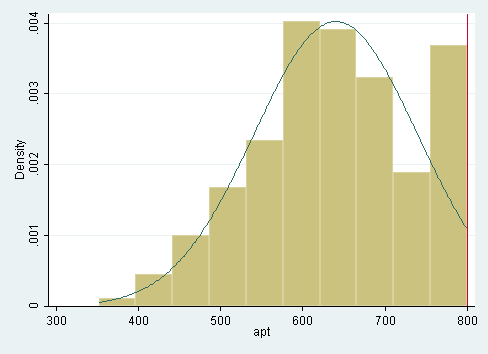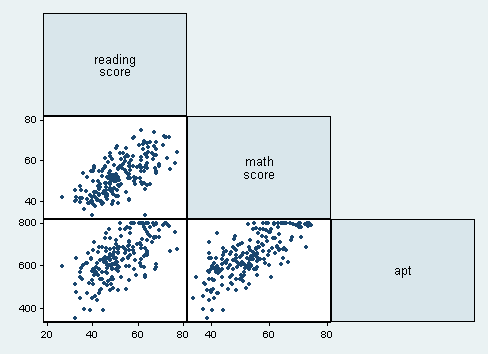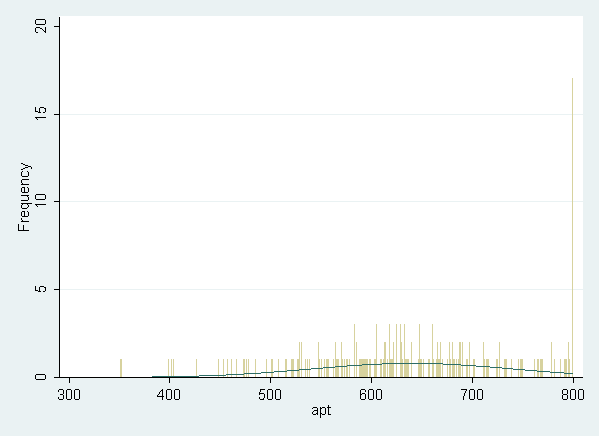Version info: Code for this page was tested in Stata 12.
The tobit model, also called a censored regression model, is designed to estimate linear relationships between variables when there is either left- or right-censoring in the dependent variable (also known as censoring from below and above, respectively). Censoring from above takes place when cases with a value at or above some threshold, all take on the value of that threshold, so that the true value might be equal to the threshold, but it might also be higher. In the case of censoring from below, values those that fall at or below some threshold are censored.
Please Note: The purpose of this page is to show how to use various data analysis commands. It does not cover all aspects of the research process which researchers are expected to do. In particular, it does not cover data cleaning and checking, verification of assumptions, model diagnostics and potential follow-up analyses.
Examples of tobit regression
Example 1.
In the 1980s there was a federal law restricting speedometer readings to no more than 85 mph. So if you wanted to try and predict a vehicle’s top-speed from a combination of horse-power and engine size, you would get a reading no higher than 85, regardless of how fast the vehicle was really traveling. This is a classic case of right-censoring (censoring from above) of the data. The only thing we are certain of is that those vehicles were traveling at least 85 mph.
Example 2. A research project is studying the level of lead in home drinking water as a function of the age of a house and family income. The water testing kit cannot detect lead concentrations below 5 parts per billion (ppb). The EPA considers levels above 15 ppb to be dangerous. These data are an example of left-censoring (censoring from below).
Example 3. Consider the situation in which we have a measure of academic aptitude (scaled 200-800) which we want to model using reading and math test scores, as well as, the type of program the student is enrolled in (academic, general, or vocational). The problem here is that students who answer all questions on the academic aptitude test correctly receive a score of 800, even though it is likely that these students are not “truly” equal in aptitude. The same is true of students who answer all of the questions incorrectly. All such students would have a score of 200, although they may not all be of equal aptitude.
Description of the data
Let’s pursue Example 3 from above.
We have a hypothetical data file, tobit.dta with 200 observations.
The academic aptitude variable is apt
Let’s look at the data. Note that in this dataset, the lowest value of apt is 352. No students received a score of 200 (i.e. the lowest score possible), meaning that even though censoring from below was possible, it does not occur in the dataset.
use https://stats.idre.ucla.edu/stat/stata/dae/tobit, clear
summarize apt read math
Variable | Obs Mean Std. Dev. Min Max
-------------+--------------------------------------------------------
apt | 200 640.035 99.21903 352 800
read | 200 52.23 10.25294 28 76
math | 200 52.645 9.368448 33 75
tabulate prog
type of |
program | Freq. Percent Cum.
------------+-----------------------------------
academic | 45 22.50 22.50
general | 105 52.50 75.00
vocational | 50 25.00 100.00
------------+-----------------------------------
Total | 200 100.00
histogram apt, normal bin(10) xline(800)

Looking at the above histogram showing the distribution of apt, we can see the censoring in the data, that is, there are far more cases with scores of 750 to 800 than one would expect looking at the rest of the distribution. Below is an alternative histogram that further highlights the excess of cases where apt=800. In the histogram below, the discrete option produces a histogram where each unique value of apt has its own bar. The freq option causes the y-axis to be labeled with the frequency for each value, rather than the density. Because apt is continuous, most values of apt are unique in the dataset, although close to the center of the distribution there are a few values of apt that have two or three cases. The spike on the far right of the histogram is the bar for cases where apt=800, the height of this bar relative to all the others clearly shows the excess number of cases with this value.
histogram apt, discrete freq
Next we’ll explore the bivariate relationships in our dataset.
correlate read math apt
(obs=200)
| read math apt
-------------+---------------------------
read | 1.0000
math | 0.6623 1.0000
apt | 0.6451 0.7333 1.0000
graph matrix read math apt, half jitter(2)

In the last row of the scatterplot matrix shown above, we see the scatterplots showing read and apt, as well as math and apt. Note the collection of cases at the top of each scatterplot due to the censoring in the distribution of apt.
Analysis methods you might consider
Below is a list of some analysis methods you may have encountered. Some of the methods listed are quite reasonable while others have either fallen out of favor or have limitations.
- Tobit regression, the focus of this page.
- OLS Regression – You could analyze these data using OLS regression. OLS regression will treat the 800 as the actual values and not as the upper limit of the top academic aptitude. A limitation of this approach is that when the variable is censored, OLS provides inconsistent estimates of the parameters, meaning that the coefficients from the analysis will not necessarily approach the "true" population parameters as the sample size increases. See Long (1997, chapter 7) for a more detailed discussion of problems of using OLS regression with censored data.
- Truncated Regression – There is sometimes confusion about the difference between truncated data and censored data. With censored variables, all of the observations are in the dataset, but we don’t know the "true" values of some of them. With truncation some of the observations are not included in the analysis because of the value of the variable. When a variable is censored, regression models for truncated data provide inconsistent estimates of the parameters. See Long (1997, chapter 7) for a more detailed discussion of problems of using regression models for truncated data to analyze censored data.
Tobit regression
Below we run the tobit model, using read, math, and prog to predict apt. The ul( ) option in the tobit command indicates the value at which the right-censoring begins (i.e., the upper limit). There is also a ll( ) option to indicate the value of the left-censoring (the lower limit) which was not needed in this example. The i. before prog indicates that prog is a factor variable (i.e., categorical variable), and that it should be included in the model as a series of dummy variables. Note that this syntax was introduced in Stata 11.
tobit apt read math i.prog, ul(800)
Tobit regression Number of obs = 200
LR chi2(4) = 188.97
Prob > chi2 = 0.0000
Log likelihood = -1041.0629 Pseudo R2 = 0.0832
------------------------------------------------------------------------------
apt | Coef. Std. Err. t P>|t| [95% Conf. Interval]
-------------+----------------------------------------------------------------
read | 2.697939 .618798 4.36 0.000 1.477582 3.918296
math | 5.914485 .7098063 8.33 0.000 4.514647 7.314323
|
prog |
2 | -12.71476 12.40629 -1.02 0.307 -37.18173 11.7522
3 | -46.1439 13.72401 -3.36 0.001 -73.2096 -19.07821
|
_cons | 209.566 32.77154 6.39 0.000 144.9359 274.1961
-------------+----------------------------------------------------------------
/sigma | 65.67672 3.481272 58.81116 72.54228
------------------------------------------------------------------------------
Obs. summary: 0 left-censored observations
183 uncensored observations
17 right-censored observations at apt>=800
- The final log likelihood (-1041.0629) is shown at the top of the output, it can be used in comparisons of nested models, but we won’t show an example of that here.
- Also at the top of the output we see that all 200 observations in our data set were used in the analysis (fewer observations would have been used if any of our variables had missing values).
- The likelihood ratio chi-square of 188.97 (df=4) with a p-value of 0.0001 tells us that our model as a whole fits significantly better than an empty model (i.e., a model with no predictors).
- In the table we see the coefficients, their standard errors, the t-statistic,
associated p-values, and the 95% confidence interval of the coefficients.
The coefficients for read and math are statistically significant, as is the
coefficient for prog=3. Tobit regression coefficients are
interpreted in the similiar manner to OLS regression coefficients; however, the linear effect
is on the uncensored latent variable, not the observed outcome. See McDonald and Moffitt (1980) for more details.
- For a one unit increase in read, there is a 2.7 point increase in the predicted value of apt.
- A one unit increase in math is associated with a 5.91 unit increase in the predicted value of apt.
- The terms for prog have a slightly different interpretation. The predicted value of apt is 46.14 points lower for students in a vocational program (prog=3) than for students in an academic program (prog=1).
- The ancillary statistic /sigma is analogous to the square root of the residual variance in OLS regression. The value of 65.67 can be compared to the standard deviation of academic aptitude which was 99.21, a substantial reduction. The output also contains an estimate of the standard error of /sigma as well as the 95% confidence interval.
- Finally, the output provides a summary of the number of left-censored, uncensored and right-censored values.
We can test for an overall effect of prog using the test command. Below we see that the overall effect of prog is statistically significant.
test 2.prog 3.prog
( 1) [model]2.prog = 0
( 2) [model]3.prog = 0
F( 2, 196) = 5.98
Prob > F = 0.0030
We can also test additional hypotheses about the differences in the coefficients for different levels of prog. Below we test that the coefficient for prog=2 is equal to the coefficient for prog=3. In the output below we see that the coefficient for prog=2 is significantly different than the coefficient for prog=3.
test 2.prog = 3.prog
( 1) [model]2.prog - [model]3.prog = 0
F( 1, 196) = 6.66
Prob > F = 0.0106
We may also wish to see measures of how well our model fits. This can be particularly useful when comparing competing models. One method of doing this is to compare the predicted values based on the tobit model to the observed values in the dataset. Below we use predict to generate predicted values of apt based on the model. Next we correlate the observed values of apt with the predicted values (yhat).
predict yhat
(option xb assumed; fitted values)
correlate apt yhat
(obs=200)
| apt yhat
-------------+------------------
apt | 1.0000
yhat | 0.7825 1.0000
The correlation between the predicted and observed values of apt is 0.7825. If we square this value, we get the multiple squared correlation, this indicates predicted values share about 61% (0.7825^2 = 0.6123) of their variance with apt. Additionally, we can use the user-written command fitstat to produce a variety of fit statistics. You can find more information on fitstat by typing search fitstat (see How can I use the search command to search for programs and get additional help? for more information about using search).
fitstat
Measures of Fit for tobit of apt
Log-Lik Intercept Only: -1135.545 Log-Lik Full Model: -1041.063
D(193): 2082.126 LR(4): 188.965
Prob > LR: 0.000
McFadden's R2: 0.083 McFadden's Adj R2: 0.077
ML (Cox-Snell) R2: 0.611 Cragg-Uhler(Nagelkerke) R2: 0.611
McKelvey & Zavoina's R2: 0.616
Variance of y*: 11230.171 Variance of error: 4313.432
AIC: 10.481 AIC*n: 2096.126
BIC: 1059.550 BIC': -167.772
BIC used by Stata: 2113.916 AIC used by Stata: 2094.126
See Also
- Stata Online Manual
- Related Stata Commands
- cnreg — censored normal regression, in which the censoring values may change from observation to observation.
- intreg — interval regression, in which observations may be point data, interval data, left-censored data or right-censored data.
References
- Long, J. S. (1997). Regression Models for Categorical and Limited Dependent Variables. Thousand Oaks, CA: Sage Publications.
- Tobin, J. (1958). Estimation of relationships for limited dependent variables. Econometrica 26: 24-36.
McDonald, J. F. and Moffitt, R. A. 1980. The Uses of Tobit Analysis. The Review of Economics and Statistics Vol 62(2): 318-321.

